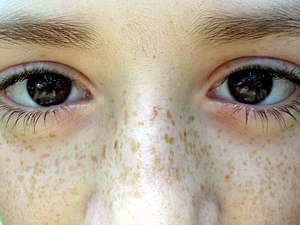Freckling
| Freckle | |
|---|---|
 |
|
| Slight facial freckles on a child. | |
| Classification and external resources | |
| Specialty | Dermatology |
| ICD-10 | L81.2 |
| ICD-9-CM | 709.09 |
| OMIM | 266300 |
| eMedicine | article/1119293 |
| MeSH | D008548 |
Freckles, sometimes called ephelides (singular ephelis), are clusters of concentrated melaninized cells which are most easily visible on people with a fair complexion. Freckles do not have an increased number of the melanin-producing cells, or melanocytes, but instead have melanocytes that overproduce melanin granules (melanosomes) changing the coloration of the outer skin cells (keratinocytes). As such, freckles are different from lentigines and moles.
The formation of freckles is triggered by exposure to sunlight. The exposure to UV-B radiation activates melanocytes to increase melanin production, which can cause freckles to become darker and more visible.
Freckles are predominantly found on the face, although they may appear on any skin exposed to the sun, such as arms or shoulders. Heavily distributed concentrations of melanin may cause freckles to multiply and cover an entire area of skin, such as the face. Freckles are rare on infants, and more commonly found on children before puberty. Upon exposure to the sun, freckles will reappear if they have been altered with creams or lasers and not protected from the sun, but do fade with age in some cases.
Freckles are not a skin disorder, but people with freckles generally have a lower concentration of photo protective melanin, and are therefore more susceptible to the harmful effects of UV radiation. It is suggested that people whose skin tends to freckle should avoid overexposure to sun and use sunscreen.
The presence of freckles is related to rare alleles of the MC1R gene, though it does not differentiate whether an individual will have freckles if they have one or even two copies of this gene. Also, individuals with no copies of the MC1R do sometimes display freckles. Even so, individuals with a high number of freckling sites have one or more of variants of the MC1R gene. Of the variants of the MC1R gene Arg151Cys, Arg160Trp, and Asp294His are the most common in the freckled subjects. The MC1R gene is also associated with red hair more strongly than with freckles. Most red haired individuals have two variants of the MC1R gene and almost all have one. The variants that cause red hair are the same that cause freckling. Freckling can also be found in areas, such as Japan, where red hair is not seen. These individuals have the variant Val92Met which is also found in Caucasians although it has minimal effects on their pigmentation. The R162Q allele has a disputed involvement in freckling.
...
Wikipedia
